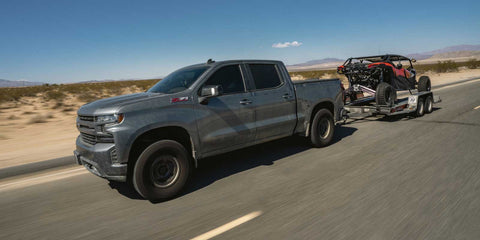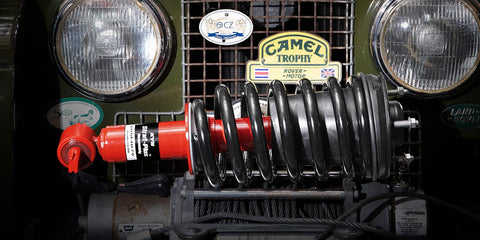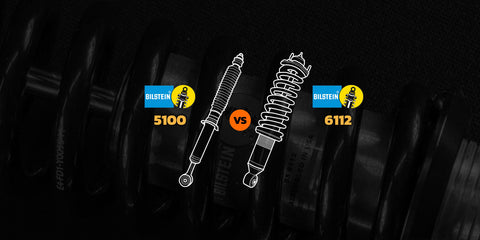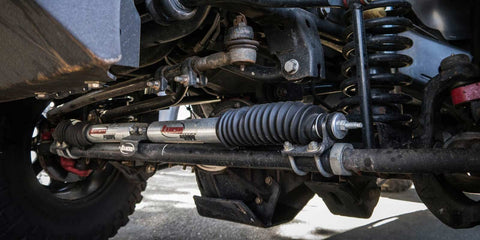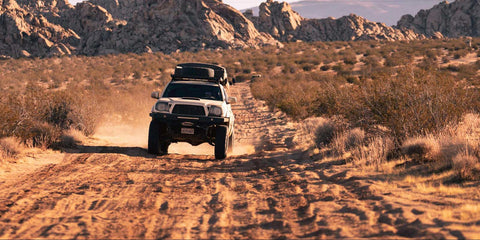SDI E-CLIK Toyota Tacoma Ride Review
Posted by Sean Reyes on
Toyota Tacoma Experience
We get excited about anything and everything Tacoma related, since there are two Tacomas on staff here at Shock Surplus. A 2006 with nearly 300k miles, and a 2015 with long travel and 37 inch tires. We have thousands of miles both on and off-road across 10 different suspension systems between both vehicles.
The amount of seat time we’ve had across Bilstein, Fox, King, Old Man Emu, Icon is arguably the most wide ranging experience in the industry. We sell it all, we test it all.
Our recommendations come from real world experience with suspension performance as the main motivation.
With that said, getting behind the wheel of the SDI Tacoma on an electronically adjustable and adaptable suspension was exciting.
R&D with SDI
We’ve taken a small part in the development of SDI’s new Tacoma E-CLIK system, our team provided the Tacoma to run R&D and prototypes on. It’s been a long journey back and forth from Lake Elsinore to get the suspension behavior dialed in.
The rear suspension provided a unique challenge, as one of the biggest advantages of the E-CLIK system is being comfortable in the slow stuff, and not missing a beat when ramping up to 60mph in the dirt. But pair that capability with the Tacoma’s factory leaf springs and it's like giving a toddler keys to a twin turbo UTV. The capability of the shocks far outweigh the ability of the base suspension.
We stated as much during our testing, the rear just never felt right, too harsh in most conditions on the trail. It would bottom out too easily in the fast stuff because you essentially only have a couple inches of travel before the bumpzone on the rear stock suspension.
The biggest piece of feedback we had for SDI shocks was that in this level of suspension, Tacoma drivers are going to be on some form of a modified leaf pack, whether its Icon’s RXT progressive leaf pack, or one of Deaver’s kits. These leaf packs have substantially more travel than factory, and feel a lot better through the full range of suspension articulation due to the progressive rate springs.
The Factory Tacoma has 3 leaf springs, with very little travel. Compare that with 7 leafs and about 25% more travel when on an aftermarket leaf-pack.
This makes a huge difference in high speed environments like the desert; it gives the shocks a lot more room to slow down the suspension in both compression and rebound.
This gives the SDI’s E-CLIK active system the ability to provide bottomless suspension whether doing 15mph on mountain trails, or 60mph through unpredictable desert. We classify bottomless suspension as a smooth transition from compression into rebound (and vice versa) without harshness.
Don't forget, we’re talking about a mid-travel system, without hydraulic bump stops. These coilovers give an additional inch or two of height, and about 20% more travel over the factory shock towers.
Tuned Up, Dialed In
The SDI Tacoma in its final form was a lot different than the R&D version we’ve been experiencing, it feels plusher overall, but tighter than factory.
We got to test two different versions; a stock-level prerunner setup, barebones and near-factory. Then we got to play with a camping and geared-out setup for some mountain adventures.
The rear shocks are now built and tuned for 1.5-2.5 inches over stock in the rear suspension in order to utilize the full potential of the shocks and active damping system. So it's advised to run an add-a-leaf pack, or full progressive-rate leaf pack. Anyone spending this kind of money on a suspension package isn’t going to run factory leaf springs most likely.
Desert Prerunner Performance
While unloaded and barebones, the truck is nimble and tight handling, like a sports car but not uncomfortable on speed bumps and driveways, that’s a plus. Usually when you have a tight handling shock from someone like Bilstein, bump compliance gets rough, but not here. It really feels like a combination of Fox comfort with Bilstein handling, whereas previously both of these brands have tradeoffs to their design.
The small chatter and easy trail stuff is evened out a bit, similar to how Fox smoothens out the edges of bumps and rocks, similar here, but without giving up body roll (a typical plush shock trade-off).
High speed is where this system shines and shows its advantages over other brands and systems.
Performance shocks like SDI and others get really smooth the faster you go, they are specifically designed to dampen at high speeds with lots of suspension articulation in the 30-50mph range. While this truck can hit 80mph on the same course as King of the Hammers, its not advised unless you’re an experienced driver and have scouted your lines.
Hitting a section of this terrain was a breeze at 50mph, the truck essentially skipped along, level, without any bucking in the front or the rear. We gave it a couple go’s between 40 and 60mph and didn’t feel bottom out contact once.
There was nothing out there that gave us pause, the new SDI system could take the biggest hits and keep the vehicle in control. Even with those unpredictable ‘oh shit’ moments we kept it throttle-down to let the suspension do its job.
Incredible. On my own '06 Tacoma, I couldn’t achieve the same performance until I installed Icon’s stage 8 system that has the hydraulic bumps in the rear.
The reason the SDI E-CLIK can accomplish this is because it is taking speed inputs from the vehicle, inputs from the shocks, and setting the shocks to full firm to prevent bottoming out the shocks. Other shocks have a problem with this because if low-speed or mid-speed valving doesn’t have enough support, then the shock will blow through that zone and the high speed valving alone cant stop the shock from hitting bottom-out.
High Speed Overlanding
The next version of the truck we got for a couple days was loaded for camping; rear bed rack, a hard shell rooftop tent, and a 70lb awning - both from Overland Vehicle Systems. We threw a cooler back there along with a bunch of our own gear to head out to Johnson Valley and Big Bear.
The weight in the rear was noticeable; there was quite a bit of a difference in the rear end with the top-heavy setup. But then I realized it was in trail mode (most comfortable). I hit street mode and lost the swishing in the rear.
I mention all this because of the impact on rear suspension performance when picking up the pace through tough terrain. When on mountain roads, body-roll becomes much more apparent when you’re loaded up for a weekend or week-long trip.
E-CLIK adapts and removes these cons of normal suspension systems, without having to make manual adjustments to your shocks (if applicable).
For all you campers and overlanders driving mountain roads, that feeling of the vehicle squishing or rolling into a corner with a heavy rear load is gone. The system keeps the vehicle level through the turn, and you can see on the in-cab module how much force is being applied to those outer shocks.
If you want to experiment, you can set the shocks to full soft, hit the corner, and watch how a 3 or 4 registers on the module, you’ll be paired with a bit of body roll. Then set the shocks to full firm and watch how a 6 or 7 registers on the controller, with much less, or no body roll at all.
This is typically called "low-speed-compression damping", to control daily driven handling and control. Bilstein is famous for this kind of damping in their 5100 or 4600 series shocks, with a trade-off of off-road performance or comfort. Icon also uses a digressive piston to better control low-speed compression damping. With digressive shocks, you feel a lot of road and trail chatter.
Fox and King on the other hand use a linear piston with a lot more oil flow, this produces great comfort but less handling prowess on-pavement and through turns.
When we got to Johnson Valley it was time to rip and open the truck up again. Even with the additional 400lbs of weight in the rear, the truck handled flawlessly.
If squishy in a good way is a thing, that’s what we felt. The system kept the vehicle handling tight, but not harsh. In the footage we were doing about 40mph, but there was plenty of intervals at 60mph with the same performance, no bottom-out and no bucking.
With all that said... This system begs you to go faster! High performance shocks get smoother the faster you go. Think about skipping a rock on a flat lake, that’s how it feels to skip over small and medium sized whoops/obstacles out in the desert on a good system.
Now I know not many people will be hitting 50mph in the desert, most people are scenic trail pilots through the forest and mountains...
Trail Cruise
Trail manners were equally comfortable; soaking up ruts and bumps without too much jarring feedback. One of the underrated benefits of the SDI system is reducing the body roll that occurs when you’re running the Tacoma with a full gear load, typically in the 500-1000lb range.
If you’ve got a soft comfortable set of Kings, you’ve got body roll on the trails. If you have Fox DSCs, you’ll have to adjust the LSC settings manually. If you have Icon CDCV, those high speed settings will need dialing back for some comfort, but you’ll still feel plenty of trail chatter from the digressive valving. Old Man Emu BP51’s can achieve the same performance, but there’s a lot of fussing with rebound and compression settings, which aren’t user friendly.
Rather than spending a few minutes showing how to control the system, we encourage you to checkout Dan, the owner of SDI, walk-through of the in-cab module linked in the description.
Final Thoughts on E-CLIK for the Tacoma
After our experience with the Tacoma across almost 10 different systems, the SDI system feels like the best of all worlds.
- Bilstein & Icon for handling
- King & Fox for comfort
- Old Man Emu BP51 for adjustability and ride refinement
- Fox Live Valve for on-the-fly automatic adaption
While the SDI kit is priced around $5k, that’s only a tad more than the highest end kits that are offered by Fox, King, and Icon. And with the traditional static tune of those systems, there are tradeoffs. There’s no compromises here, and if you want the best, then SDI is likely the answer for the Tacoma platform.
In the end, the main thing to remember is that the SDI E-CLIK system combines the best of many shock designs into a single package.











